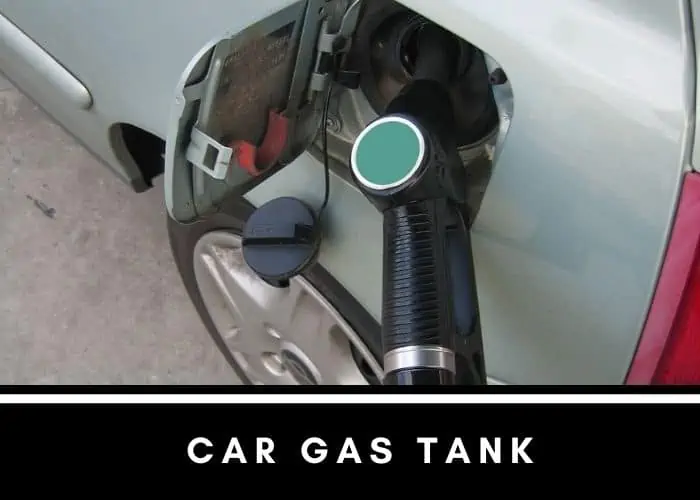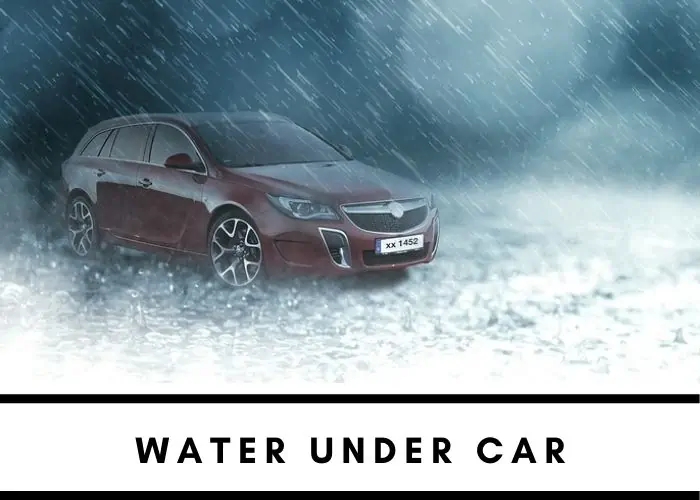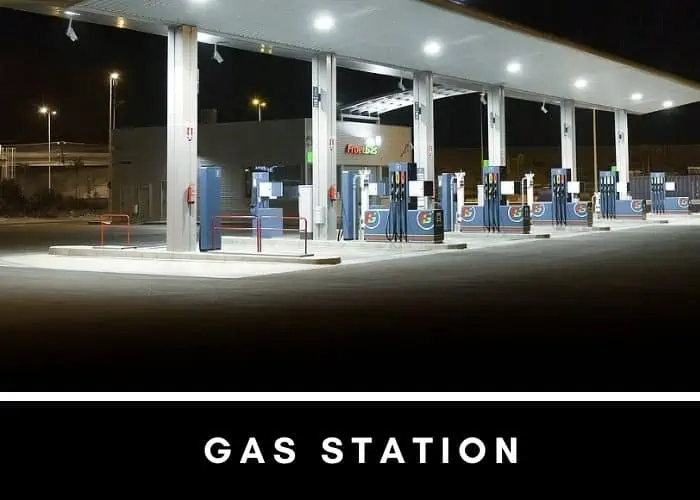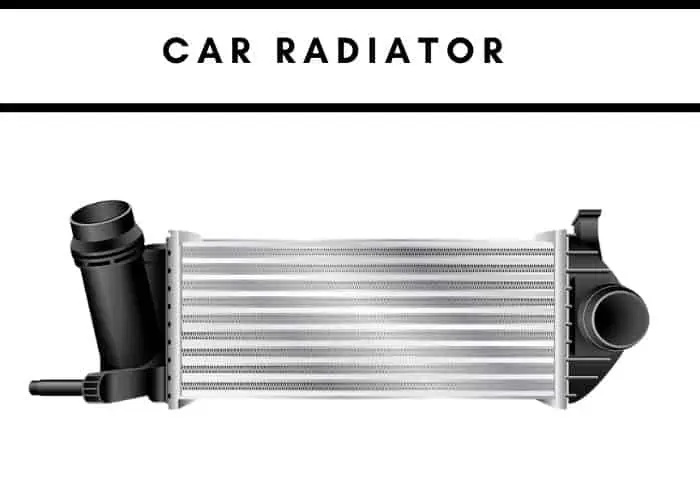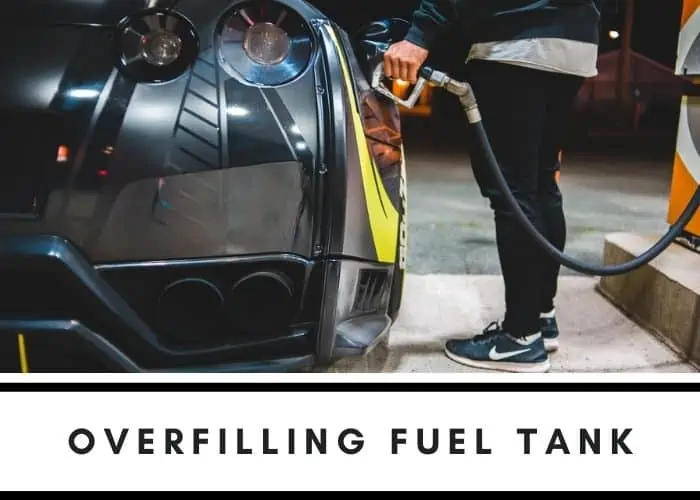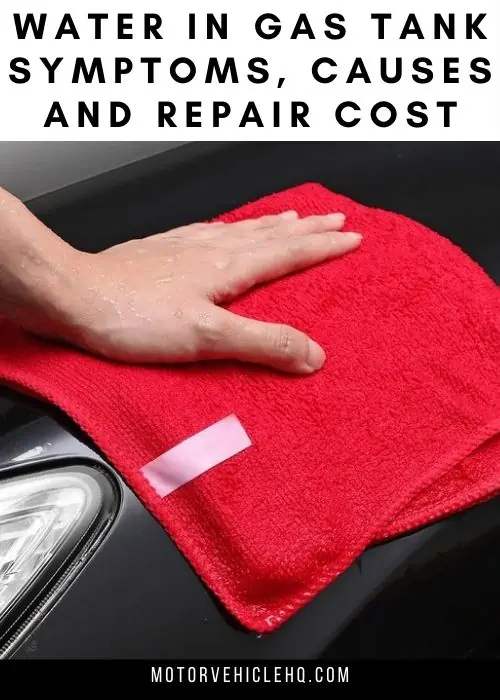Water and gasoline don’t mix, so it’s not uncommon for the water to find its way into your gas tank. Water can cause corrosion, rust, and gum up the works — it can ruin your engine.
If there is much water in your tank, it could cause you to stall while driving or even prevent your vehicle from starting.
It can lead to expensive water in gas tank repair cost because of fuel pump failure or clogged fuel filters caused by water contamination.
Your car’s gas tank can cause water in the gas tank due to condensation or moisture buildup. A gas tank exposed to the elements may be at risk for this problem.
In some cases, you may even experience problems with your engine because of corroded parts that were never properly sealed from moisture in the first place.
Symptoms of Water in Gas Tank
Vehicle Is Sluggish or Slow To Respond When Accelerating
If your vehicle is sluggish or slow to respond when accelerating, it may be caused by a clogged fuel filter or a clogged fuel injector.
If you recently replaced the fuel filter, you need to reset it. To accomplish this, remove the gas cap and wait several minutes before screwing it back.
Then turn your ignition off and restart the engine. This procedure should allow the fresh gas to pass through the system for about 60 seconds before shutting off again.
Repeat this process three times before turning off your engine for good and filling up with fresh gasoline.
The Engine Runs Poorly and Then Dies
You should pull over immediately if you smell gas or see steam coming from the exhaust. If this happens, turn off the engine and call for help.
If your car runs poorly and then dies, it could just be a bad battery. But this might also be a sign of water in your gas tank.
Gasoline Smell Inside the Car
The gasoline smell inside your car is a pretty strong indicator that water has entered the gas tank.
If you notice a distinct odor of gasoline in or around your vehicle, it’s crucial to fix this issue as soon as possible.
If you’re unsure about what’s causing this smell, there are a few other things to look out for:
- The smell of fuel outside the car is a sign that there is a leak somewhere under the hood.
- Black smoke from the tailpipe indicates a problem with the catalytic converter or engine oil pressure sensor.
To prevent water from entering the gas tank, check for leaks or cracks in the fuel lines, which you should replace if found damaged. If no leaks are apparent and you still suspect water is entering your vehicle’s fuel system, you will likely need to change the fuel filter before starting your engine again.
Water Condensation Under the Vehicle
Water condenses in your car’s gas tank can cause problems. The most common symptom is a leaky fuel line.
If you see gasoline dripping from the underside of your vehicle, it could be a sign that there’s water in your gas tank — and if so, you should get a mechanic to check it as soon as possible.
Other symptoms include:
- Loss of power.
- Car stalling when driving at high speeds.
- A strong gasoline smell throughout the cabin.
Engine Won’t Stop Running
The engine continues to run after the key is removed from the ignition. If you’re experiencing any of these symptoms, your car may have water in the gas tank.
To fix this issue, you need to have your vehicle towed to a shop that can drain and replace your fuel tank.
Chugging Noise When Driving or Acceleration
If your car makes a chugging noise while accelerating, you may have water in the gas tank.
A loss of power or acceleration can also be a sign that you have water in your gas tank. If this is the case, it’s time to drain some out and get back on the road.
If you notice that your car is not running or accelerating as quickly or powerfully as before, this could indicate that there is water in your gas tank.
Water causes corrosion, which you need to remove before you make any repairs.
Surging or Lack of Power at Higher Speeds
If you’re experiencing surging or lack of power at higher speeds during acceleration. A faulty fuel pump, faulty fuel injector, or fuel filter can cause this.
If your car has a lot of power, but it’s hard to get up to speed, and once you do, it feels like the engine is winding down, that could mean that you have an air leak in one of your emission control devices.
A faulty battery gauge could also cause this issue. It’s important to remember that these symptoms do not necessarily mean that there is water in your gas tank.
The most common reasons for these issues are bad fuel or a clogged fuel filter. If you think you have water in your gas tank, contact an auto repair shop immediately for assistance.
Always check the fuel cap when filling up your car at a gas station. If it’s loose or missing, water can get into your gas tank and cause damage to your engine.
Causes of Water in the Car Gas Tank
Water Enters the Tank at a Gas Station
Water can enter the gas tank through the fuel filler neck. The fuel filler neck is located on top of the fuel tank, and it’s directly connected to the gas cap via a hose rubber seal.
However, if this seal fails for any reason (for example, if you accidentally hit your vehicle while filling up), water can be sucked into the tank through this connection and cause problems. Water can also infiltrate through a loose or damaged gas cap.
When you remove your car’s regular-sized gas cap, replace it with an oversized one required by some states during winter months.
Some rubber sealant gets stuck inside or around its threads — and when you screw back on your regular-sized one later, it doesn’t seal properly anymore and lets water in!
Condensation Builds Up in the Tank
Condensation occurs when a gas (such as air) cools down quickly, and its vapor changes back into liquid.
The water that forms can be caused by an increase in temperature, which is also why we exhale little puffs of steamy breath on a cold morning.
Condensation builds up in your car’s gas tank when the fuel cools down after being pumped into the tank from underground storage tanks at stations.
This process happens every time you fill up at the pump, so it’s normal for your car to have some condensation built-up inside its fuel system.
Bad Fuel Lines
You might be wondering: what’s the difference between water in my fuel lines and water in my tank? The answer is that there is no difference.
Water in your gas tank can also cause water to enter the long, thin metal tubes that connect your gas pump to your engine.
The Gas Cap Is Loose and Allowing Water To Seep Into the Tank
The most common cause of water in the car gas tank is a loose or damaged gas cap.
The purpose of the gas cap is to keep moisture out, but if it’s not tight enough or rust or corrosion has damaged it, it can’t do its job properly.
Another possible explanation for this issue is that you have an incompatible size or shape of container connected to your car: If you’re using a smaller container than the original installation on your vehicle, it may be leaking.
Faulty Engine Parts
Faulty engine parts can be of metal or plastic, and wear and tear, rust or corrosion,
overheating, and improper maintenance can damage them.
The following are some examples of faulty engine parts:
- A faulty intake manifold gasket could cause a leak in the intake manifold. It would allow water to get into the gas tank.
- A leaking oil seal on your engine’s crankshaft could let water seep into your car’s gas tank through the crankcase breather pipe (also known as an oil pan).
- A timing belt that has broken or slipped off its pulleys will cause air to enter your combustion chamber through the open valves. It allows water vapor from outside your car to enter.
A ruptured car radiator can cause water to enter the gas tank. The most common reason is that the radiator has sprung a leak, which allows the coolant that circulates the engine to escape. As a result, water from the cooling system can seep into the gas tank and mix with gasoline.
Engine Coolant Leaks Into the Tank
The engine coolant can leak into the gas tank if your car overheats. It can cause a buildup of white smoke coming from the tailpipe.
A ruptured radiator hose or a failing water pump in the coolant in your gas tank can cause it.
A Leak in the Evaporative Emissions System
As you drive your car, it collects fuel vapors and pulls them into a canister, which sends those fumes out through the tailpipe.
Some sensors detect whether there’s water in the gas (and they’re supposed to shut off the engine if they detect any).
If your car doesn’t have one of these systems or the sensor isn’t working properly — or even if you’ve replaced it with an aftermarket part — that means that when you fill up with gas, some will slosh into places where it doesn’t belong.
A Crack in Your Car’s Fuel Tank
A car’s fuel tank crack can cause water to seep in. If you see any water in the fuel tank, stop driving immediately and get it checked out by a mechanic.
It will help prevent any serious damage from occurring due to the water leaking into your engine.
Bad Fuel Quality
The gasoline source is often from several refineries and plants, and it may contain water or other contaminants that are not removed during processing.
When this happens, the water will contaminate your fuel tank and cause moisture to build up.
The water can corrode certain parts of your vehicle’s fuel system, clogging them — causing problems like stalling or poor acceleration.
Bad Fuel Injectors and Fuel Pump Seals
Fuel injectors. These are small nozzles that spray fuel into the engine. They can get clogged up with dirt or rust, which will cause water to find its way into your tank.
Fuel pump seals. It keeps the fuel from leaking out of the fuel pump and onto the ground when you fill up at a gas station.
It sounds like a small problem, but it’s one of the most likely culprits when water gets into your tank.
Factors Affecting Repair Cost for Water in Fuel Tank
The water in gas tank repair cost will depend on several factors:
- The car or truck type.
- The vehicle make and model.
- Water contamination (i.e., rust holes) has damaged the fuel system.
You should know there are several repair services for your fuel tank. These include fuel tank:
- Repair.
- Replacement.
- Cleaning.
The cost of each service depends on the damage the water has done to your vehicle’s fuel system.
Water in Gas Tank Repair Cost
Wondering how much it costs to repair water in a vehicle’s fuel tank? The answer depends on whether you have a car that’s still under warranty.
If your vehicle is new and the manufacturer still offers coverage for your new car, then they will cover all costs associated with repairing any damage caused by water contamination.
You’ll need to pay out of pocket for repairs if you don’t have a warranty or purchased your vehicle before the warranties were in place. It depends on what type of damage your car has.
For example, changing out an entire fuel system can cost between $300-$450, while replacing just one sensor may run as low as $75-$100 depending upon where exactly inside your vehicle’s engine bay needs fixing up.
A damaged fuel tank can cause water to leak into your gas tank, which can lead to rusting and corrosion inside the engine that could cost a lot of money to fix.
The cost of repairing a water-damaged fuel tank can vary from vehicle to vehicle. The average cost of repairing a water-damaged fuel tank is about $1,200 to $1,500, but this may vary depending on the car type and where you live.
How To Repair Water in Gas Tank
Water in a gas tank is not only annoying, but it can also cause some serious damage to your car.
The following steps will help guide you through the process of repairing your water-damaged tank and keeping it from happening again:
Step 1: Drain Your Gas Tank
You will need to drain the tank. You can remove the gas cap and pull out a hose connected to your car’s fuel line.
It will allow you to siphon off any water in the tank, ensuring that it doesn’t get into your engine when you fill-up with gas later on.
To remove water from your vehicle’s gas tank, you’ll need:
- A bucket or other container (for storing excess water)
- A funnel (to make sure all the water drains out of your car)
Step 2: Clean the Water From Your Tank
Once you’re certain that the water is gone from your gas tank, you can begin cleaning it.
You should also check for rust spots; if they are bad enough, sand them down.
A drain hose is another way of removing excess water from your tank. Ensure that you clean the hose so as not to add any additional bacteria or dirt.
Step 4: Fill Up Your Tank
Once your tank has been cleaned and dried, fill it with fresh gas. Remember to use a funnel when pouring in the fuel.
Don’t overfill your fuel tank. Overfilling can cause fuel to spill out or even get into the engine and damage it.
It’s important not to overfill the tank; if you do, some excess will spill out of your car.
Also, don’t add additives to your tank at this point; you’ll want to ensure that any remaining water has been removed first by driving around a bit before doing so.
Common Questions and Answers
What causes the water in the gas tank?
Water can get into the gas tank through the fuel filler neck. Over time, dirt and other contaminants get stuck in the rubber gasket surrounding the filler neck.
When you fill up your car with gas, these contaminants dissolve into the gasoline as it goes down through this gasket.
Eventually, they can build up enough to form a layer of water that overtops your fuel.
Is the water in a gas tank bad for a car?
The short answer is yes. Water in your gas tank can cause corrosion and rust, which can lead to your gas tank cracking or leaking.
The fuel pump could also fail if it’s damaged by moisture, as could the fuel injectors, which are affected by corrosion.
Can you put water in a gas tank to clean it out?
No, you should not put water in your gas tank. It could cause serious damage to your car and result in a malfunction of the fuel system.
Water can also cause corrosion in the tank and/or on electrical components, which may lead to an electrical short that could leave you stranded on the side of the road.
If there is any water in your car tank when you refuel it with gasoline, evaporation will occur — but at a faster rate.
How do you remove water from the gas tank?
There are different ways you can remove water from your gas tank. You can use commercial fuel tank cleaners, which work by injecting an enzyme into your vehicle’s fuel system.
They break down any rust or other particles that may be causing problems with proper functioning.
Another way to remove excess water from your car’s fuel system is through a dryer (also known as a dewatering agent).
This product works by attracting moisture with its absorbent crystals, allowing it to drain away easily and safely.
Finally, you will find commercial water separators on the market that effectively separate any unwanted substances floating in your gas tank — including dirt particles.
Conclusion
It is essential to understand that the water in tank repair cost, symptoms, and causes can be costly if not caught early on.
It’s best to keep an eye out for any signs of water in your gas tank so that you can repair it before it does damage your vehicle.
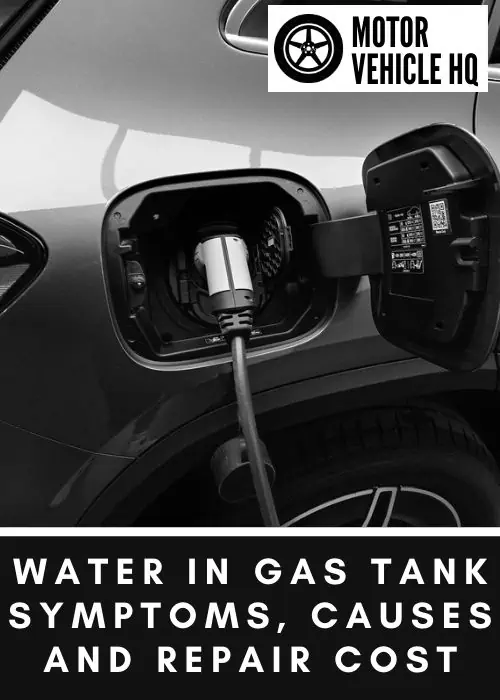

Jim Wicks is the founder of MotorVehicleHQ. With over two decades of experience in the automotive industry and a degree in Automotive Technology, Jim is a certified car expert who has worked in various roles ranging from a mechanic, car dealership manager, to a racing car driver. He has owned more than 20 cars over the past 15 years. Ask him about any vehicle you see on the road and he can tell you the make, model and year. He loves the aesthetics of all things cars, and keeps his vehicles in pristine condition.
In his free time, Jim enjoys getting his hands dirty under the hood of a classic car or taking long drives along the country roads. His favorite car? A 1967 Shelby GT500, a true classic that, according to Jim, “represents the pure essence of American muscle.”
